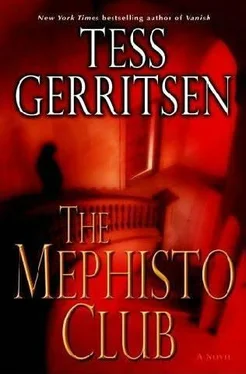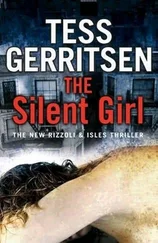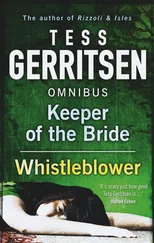Jane sighed. “You know, Mr. Stark-”
“No one calls me that. I’m Ollie.”
Jane sat down so that her gaze was level with his. He met her look with one of mild amusement, and it irritated her. It said: I’m smart and I know it. Certainly smarter than some policewoman. It also irritated her that he was probably right; he looked like the stereotypical boy genius that you always dreaded sitting next to in math class. The kid who handed in his algebra exam while everyone else was still struggling with problem number one.
“We’re not trying to mess up your usual protocol,” said Oliver. “We just want to be helpful. And we can be, if we work together.”
Upstairs, the dogs were barking, claws tapping back and forth across the floor as Edwina shushed them, and a door thudded shut.
“You can help us by just answering our questions,” said Jane.
“I think you misunderstand.”
“What am I not getting?”
“How useful we can be to you. Our group.”
“Right. Mr. Sansone told me about your little crime-fighting club.”
“It’s a society, not a club.”
“What’s the difference?” asked Frost.
Oliver looked at him. “Gravity, Detective. We have members around the world. And we’re not amateurs.”
“Are you a law enforcement professional, Ollie?” asked Jane.
“Actually, I’m a mathematician. But my real interest is symbology.”
“Excuse me?”
“I interpret symbols. Their origins and their meanings, both apparent and hidden.”
“Uh-huh. And Mrs. Felway?”
“She’s an anthropologist. She just joined us. Came highly recommended from our London branch.”
“And Mr. Sansone? He’s certainly not law enforcement.”
“He might as well be.”
“He told us he’s a retired academic. A Boston College history professor. That doesn’t sound like a cop to me.”
Oliver laughed. “Anthony would underplay himself. That’s just like him.”
Edwina came back into the kitchen, carrying a file folder. “Just like whom, Ollie?”
“We’re talking about Anthony. The police think he’s just a retired college professor.”
“And that’s just the way he likes it.” Edwina sat down. “It doesn’t help to advertise.”
“What are we supposed to know about him, anyway?” asked Frost.
“Well, you know he’s quite wealthy,” said Edwina.
“That was pretty obvious.”
“I mean, seriously wealthy. That house on Beacon Hill, it’s nothing compared to his estate in Florence.”
“Or his house in London,” said Oliver.
“And we’re supposed to be impressed by that?” said Jane.
Edwina’s response was a cool stare. “Money alone seldom makes a man impressive. It’s what he does with it.” She placed the file folder on the table in front of Jane. “For you, Detective.”
Jane opened the folder to the first page. It was a neatly typed chronology of last night’s events, as recalled by three of the dinner guests, Edwina and Oliver and the mysterious Gottfried Baum.
(All times are approximate)
6:00: Edwina and Gottfried arrive
6:15: Oliver Stark arrives.
6:20: Joyce O’Donnell arrives.
6:40: First course served by Jeremy…
The entire menu was listed. Consommé followed by salmon aspic and a salad of baby lettuces. Beef tournedos with crisp potato cakes. A tasting of port to accompany slivers of Reblochon cheese. And finally, with coffee, a Sacher torte and thick cream.
At nine-thirty, Edwina and Gottfried departed together for Logan Airport, where Edwina dropped Gottfried off for his flight to Brussels.
At nine forty-five Oliver left Beacon Hill and drove straight home.
“And that’s what we remember of the timeline,” said Edwina. “We tried to be as accurate as possible.”
Right down to the consommé, thought Jane, scanning the chronology. There was nothing particularly helpful here; it repeated the same information that Sansone and his butler had already provided, but with the additional culinary details. The overall picture was the same: A winter’s night. Four guests arrive on Beacon Hill within twenty minutes of one another. They and their host share an elegant supper and sip wine while they discuss the crimes of the day, never realizing that, just outside, in the frigid garden behind their building, a woman was being murdered.
Some crime-fighting club. These amateurs are less than useless.
The next page in the folder was a sheet of stationery with only a single letter printed at the top: “M,” in a gothic font. And beneath it, the handwritten note: “Oliver, your analysis? A.S.” Anthony Sansone? Jane flipped to the next page and stared at a photograph that she immediately recognized: the symbols that had been drawn on Sansone’s garden door.
“This is from the crime scene last night,” said Jane. “How did you get this?”
“Anthony sent it over this morning. It’s one of the photos he took last night.”
“This isn’t meant for public distribution,” said Jane. “It’s evidence.”
“Very interesting evidence,” said Oliver. “You know the significance, don’t you? Of those symbols?”
“They’re satanic.”
“Oh, that’s the automatic answer. You see weird symbols at a crime scene and you just assume it’s the work of some nasty satanic cult. Everyone’s favorite villains.”
Frost said, “Do you think this is something else?”
“I’m not saying this couldn’t be a cult. Satanists do use the reverse cross as a symbol of the Antichrist. And that slaying on Christmas Eve, the one with the decapitation, there was that circle drawn on the floor around the victim’s head. And the burned candles. That certainly calls to mind a satanic ritual.”
“How do you know about all this?”
Oliver glanced at Edwina. “They really think we’re clueless, don’t they?”
“It doesn’t matter how we learned the details,” said Edwina. “The fact is, we do know about the case.”
“Then what do you think about this symbol?” asked Frost, pointing to the photograph. “The one that looks like an eye? Is that satanic as well?”
“It depends,” said Oliver. “First, let’s consider what you saw at the Christmas Eve death scene. There was a red chalk circle where he’d placed the victim’s severed head. And there were five candles burned at the perimeter.”
“Meaning?”
“Well, circles in and of themselves are quite primitive symbols, and they are universal. They can mean all sorts of things. The sun, the moon. Protection. Eternity. Rebirth, the cycle of life. And yes, it’s also used by satanic cults to represent the female sexual organ. We don’t really know what it meant to the person who drew it that night.”
“But it could have a satanic meaning,” said Frost.
“Of course. And the five candles may represent the five points of a pentagram. Now, let’s look at what was drawn last night, on Anthony’s garden door.” He pointed to the photograph. “What do you see?”
“An eye.”
“Tell me more about this eye.”
“It’s got, like, a teardrop. And an eyelash sticking out below it.”
Oliver took a pen from his shirt pocket and flipped the sheet of stationery to its blank side. “Let me draw it more clearly, so you’ll see exactly what the different elements are in this symbol.” On the sheet of paper, he reproduced the drawing:
“It still looks like an eye,” said Frost.
“Yes, but all these features-the eyelash, the teardrop-that makes it a very specific eye. This symbol is called Udjat. Experts on satanic cults will tell you this is a symbol for Lucifer’s all-seeing eye. The teardrop is because he mourns for those souls outside his influence. Some conspiracy theorists claim it’s the same eye printed on U.S. currency.”
Читать дальше












